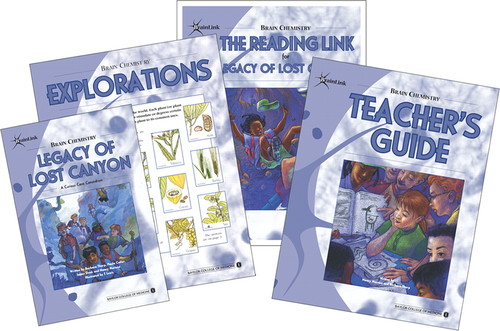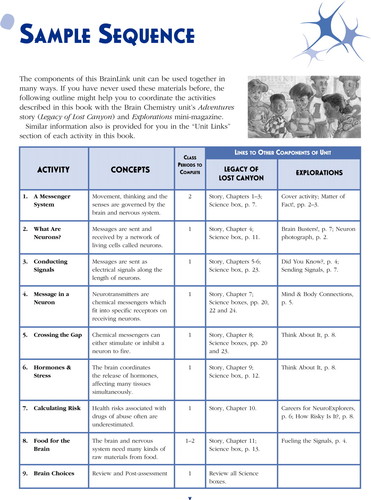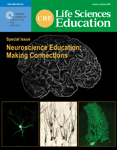BrainLink: A Review of a Model Curriculum Integrating Science, Reading, and Cooperative Learning Groups for Middle School Students
In fall 1999, I had just begun working to implement a neuroscience program for fifth- to eighth-grade teachers and students and was looking for neuroscience-related materials and ideas targeting middle school students. This search led me to discover the BrainLink materials from Baylor College of Medicine. After using BrainLink activities in a variety of situations over the ensuing five years, I have repeatedly confirmed that the materials are informative, engaging, and accessible to a wide range of learning styles.
BRAINLINK THEMES AND CONTENT
The BrainLink curriculum materials, originally published in 1997, are centered on the themes of comparative anatomy, memory and learning, motor systems, and sensory systems. Authorship of BrainLink materials is shown in Table 1 and ISBN numbers in Table 2.
| Curriculum material | Sensory systems (1997) | Motor highways (1997) | Brain comparisons (1997) | Memory/learning (1997) | Brain chemistry (2003) |
|---|---|---|---|---|---|
| Teacher guides | Nancy Moreno, Leslie Miller, Barbara Tharp, Katherine Taber, Karen Kabnick, and Judith Dresden | Nancy Moreno, Leslie Miller, Barbara Tharp, Katherine Taber, Karen Kabnick, and Judith Dresden | Leslie Miller, Barbara Tharp, Judith Dresden, Katherine Taber, Karen Kabnick, and Nancy Moreno | Nancy Moreno, Barbara Tharp, Judith Dresden, Katherine Taber, and Leslie Miller | Nancy Moreno and Barbara Tharp |
| Adventure books | Grace Boyle (Judith Dresden, Barbara Tharp, and Nancy Moreno)a | Grace Boyle (Barbara Tharp, Judith Dresden, and Nancy Moreno)a | Grace Boyle (Judith Dresden, Barbara Tharp, and Nancy Moreno)a | Dane Chetkovich (Barbara Tharp, Judith Dresden, and Nancy Moreno)a | Barbara Tharp, Paula Cutler, James Denk, and Nancy Moreno |
| Explorations | Baylor College of Medicine | Baylor College of Medicine | Baylor College of Medicine | Baylor College of Medicine | Baylor College of Medicine |
| Reading links | Baylor College of Medicine | Baylor College of Medicine | Baylor College of Medicine | Baylor College of Medicine | Baylor College of Medicine |
| Sensory systems (1997) | Motor highways (1997) | Brain comparisons (1997) | Memory/learning (1997) | Brain chemistry (2003) | |
|---|---|---|---|---|---|
| Teacher guides | 1-888997-23-0 | 1-888997-22-2 | 1-888997-21-4 | 1-888997-24-9 | 0-89278-044-4 |
| Adventure books | 1-888997-19-2 | 1-888997-18-4 | 1-888997-17-6 | 1-888997-20-6 | 0-89278-046-0 |
| Explorations | 1-888997-27-3 | 1-888997-26-5 | 1-888997-25-7 | 1–888997-28–1 | 0–89278-045–2 |
| Reading links | N/A | N/A | N/A | N/A | N/A |
An additional unit on brain chemistry was published in 2003. All of the units have been designed to engage middle school (fifth to eighth grade) teachers with the goal of increasing their understanding of neuroscience and health-related concepts.

The Brain Chemistry unit focuses on the role of chemical communication in neural transmission, making links to hormones and drug effects on brain and body functions. Among other activities, it uses an interesting card game to give students practice in sequencing events during neural communication.
The Brain Comparisons unit focuses on comparative brain anatomy and physiology, culminating with an intriguing activity that asks students to design an imaginary animal's brain and describe how the brain characteristics fit the animal's abilities.
The Memory and Learning unit focuses on how the brain stores and retrieves information, and describes several learning styles and methods to improve declarative memory. Toward the end of the unit, the readings include biographies of scientists who had learning disabilities, yet were successful in their careers.
The Motor Highways unit focuses on how the nervous system regulates involuntary and voluntary movements and introduces the concept of the motor homunculus. The end of this unit also provides biographies, this time of famous individuals with motor disabilities.
The Sensory Signals unit focuses on sensory receptive fields and optical illusions and how the brain processes information from the senses. This unit contains at least one activity for each of the five most commonly described senses.
ORGANIZATION OF UNIT CURRICULUM COMPONENTS
Each unit consists of four components: a teacher guide, an adventure book, an explorations magazine, and a reading link. Resource kits containing the materials to implement all of the activities are also available for purchase. The teacher guides contain detailed descriptions of inquiry-based, hands-on activities. The Adventure storybooks are illustrated reading materials for students that describe science and health concepts. The Explorations magazines use a more graphic format to present activities and information suitable for students and adults in classrooms or at home. The Reading Links contain language arts activities related to each BrainLink Adventure storybook. The integration of reading, math, and science into each of the units is impressive and is intended to enhance student learning across a broad range of skill sets.
Each unit is designed to take 10–12 class periods, assuming 45–60-minute class periods. Although I have not taught an entire unit, I have used individual activities from the teacher guides as individual lessons to illustrate particular concepts. My favorites have been Brain Comparison's “Comparing Brains” activity, using rabbit and cat plaster models to examine how the size and shape of brain parts vary among mammals, and Memory and Learning's “Practice Makes Memories” to experience how practice improves a new motor skill.
Each teacher guide begins with two sections: “Where do I begin?” and “Using cooperative groups in the classroom.” The first section orients the reader to the layout of the teacher guide, and the second describes the utility of cooperative groups as a teaching/learning strategy and explains how to set up cooperative groups. Next, each guide contains a sample sequence of activities, adventures, and explorations. The sample sequences (see Figure 1) provide a suggested progression for the activities, an overview of core concepts, and estimates of time for each activity along with suggested readings from the Adventures and Explorations components. In addition, the teacher guides provide cumulative lists of materials for all of the activities, as well as a list at the beginning of each individual activity. Each activity includes background information for the teacher as well as a “brain-jogging” section that presents potential extension activities. All of the units contain preassessment/focus activities and postassessment activities in the teacher guide.

Figure 1. Sample sequence for the components of the Brain Chemistry unit.
A sample activity called “Practice Makes Memories” from the Memory and Learning teacher guide can be downloaded from: http://www.ccit.bcm.tmc.edu/ceo/home/content_images/TG_Sample_BL3.pdf.
All of BrainLink's Adventure storybooks describe the problem-solving activities of seven kids who have formed the NeuroExplorers club. Each book begins with a description of how the club was formed, as well as each of the main characters. As a result, each book may stand alone or be used as part of a sequence of BrainLink units. The club's members represent a variety of cultural backgrounds, providing opportunities for different readers to identify and connect with characters they may view as being similar to themselves. Supporting characters include scientists and individuals with neurological disabilities as role models and as a connection between neuroscience concepts and individuals' lives. All of the books contain a theme of problem-solving puzzles, and most illustrate the importance of teamwork to accomplish tasks. In addition to the storyline, each book contains sidebar boxes describing specific neuroscience information about major brain structures and function and neuronal function. Each book also contains a glossary of vocabulary words, although many words are defined in context, as in the following example:
“That's right,” she said, finally. “And to fit all that cerebral tissue inside the cranium, the brain surface is folded over many times. Those wrinkles are called gyri, and they make marks on the inside of the cranium. So the more marks, the more advanced the brain.”
(Brain Comparisons, p. 19)
One point to note is that the Brain Chemistry: Legacy of Lost Canyon is written at a slightly higher reading level (seventh and eighth grade), with no color illustrations. This book discusses drugs, both legal and illegal, and how they affect brain function.
The Explorations magazines are designed to present small pieces of information along with short activities that could be done in after-school programs and at home as easily as in the classroom. Each of the magazines includes a health-related section, profiles a neural-related career path, and most include a Far Side cartoon to examine in the context of a neuroscience concept.
Each of the Reading Link booklets follows a format similar to the others, including student worksheets to focus on multiple meanings for words, vocabulary building in context, and higher-level science and reading comprehension skills. These skills include sequencing, summarizing, determining cause/effect, comparing/contrasting, making inferences, predicting, and drawing conclusions.
All of the BrainLink materials have been reviewed extensively for both their science content and pedagogical approaches by a panel of national advisors and have been pilot tested in classrooms across the United States. The materials also have been aligned with the National Science (http://www.nap.edu/readingroom/books/nses/html/) and Health (http://www.csun.edu/∼vceed002/standards/health/national_health_standards.html) Education Standards.
INCORPORATING BEST PRACTICES/INSTRUCTIONAL TECHNIQUES
BrainLink activities also provide valuable learning experiences for students. Throughout the BrainLink materials, certain instructional strategies are consistently used. The following highlight some of these strategies in terms of their potential impacts on student learning. Marzano et al. (2001) discuss a meta-analysis of overall effects of various instructional techniques. Nine techniques were identified as having the strongest effects: 1) identifying similarities and differences; 2) summarizing and note taking; 3) reinforcing effort and providing recognition; 4) homework and practice; 5) nonlinguistic representations; 6) cooperative learning; 7) setting objectives and providing feedback; 8) generating and testing hypotheses; and 9) cues, questions, and advance organizers.
In particular, five of these techniques are highly represented in the BrainLink materials, including identifying similarities and differences, summarizing and note taking, creating nonlinguistic representations, generating and testing hypotheses, and using cooperative learning groups. BrainLink strategies range from simple compare/contrast prompts like, “How is this (balloon model) like a real brain? How is it different?” (see Brain Chemistry teacher guide, p. 3) to nonlinguistic representations such as making models of a spinal cord out of string and straws (Motor Highways Explorations, p. 5) and of electrical communication using salty water, wires, a small battery, and a light bulb (Brain Chemistry teacher guide, pp. 11–14).
BrainLink activities also include numerous uses of cues and questions that prompt students to generate and test hypotheses:
“Put in earplugs. Have several people talk softly or pretend to talk with you. Can you tell who is really making the sounds and who is pretending? How might you be able to tell? What sense or senses could you use? Can you figure out what they are saying by watching their lips or by touching their throats?”
(Sensory Signals Explorations, p. 5)
And as mentioned earlier, each teacher guide emphasizes the use of cooperative groups in many activities. The use of such groups has been identified as a significant tool both to teach content and also to raise student self-esteem (Jackson and Davis, 2000, p. 48; Zemelman et al., 1998, p. 12).
Throughout all of the BrainLink materials, the authors incorporate open-ended questions that are directed at the reader, bringing a more active interaction between the text and the audience:
“NASA scientists have used spider web patterns to investigate the effects of possibly toxic chemicals. The web on the left represents a normal pattern. The web on the right was created by a spider after being exposed to marijuana. What happened?”
(Brain Chemistry Explorations, p. 8)
The design and integration of the BrainLink components and units is admirable, both in terms of the content presented and the variety of pedagogical approaches modeled to improve instructional practice. In addition to offering activities for an entire 10–15 class period unit, each of the component parts may stand on its own. This flexibility makes the materials especially useful in a wide range of classrooms. The materials are accessible to classroom teachers as well as to scientists who are developing materials that would engage a middle school audience.
Beyond the specifics of the content and teaching techniques, BrainLink also is an excellent example of a well-constructed curriculum, flexibly designed for use in a wide range of settings. I would recommend BrainLink materials to anyone looking for ideas about how to present any of the covered content to fourth- to ninth-grade students and also to anyone thinking about designing a curriculum for the same age range. That said, the teaching strategies would be useful in any classroom, K–20, when language and conceptual frameworks are scaled to the level of the intended learner.
FOOTNOTES
1 For BrainLink materials authorship, please see Table 1. For BrainLink materials ISBN numbers, please see Table 2.
2 Currently available (as of October 2005) through Carolina Biological Supply Company: Teacher guides: $19.95 each, Adventure books: $6.95 each, Reading links: $5.95 each, Explorations: $1.95, and Complete class kits: $225.95–312.95.
3 The authors are negotiating with a new publisher to republish/reproduce all of the teaching and kit materials.
4 The current BrainLink Web site is at the following address: http://www.ccit.bcm.tmc.edu/ceo/content.cfm?menu_id=99



